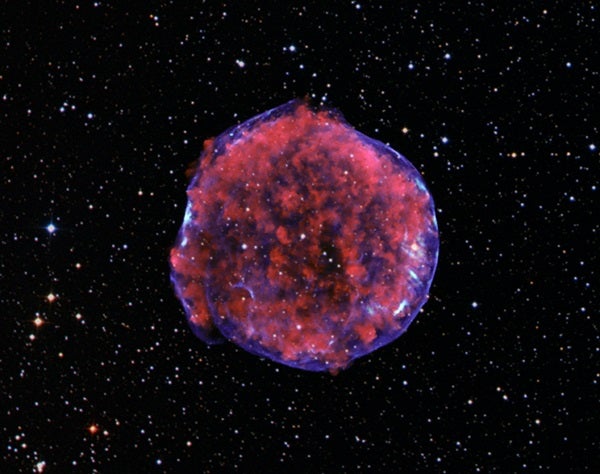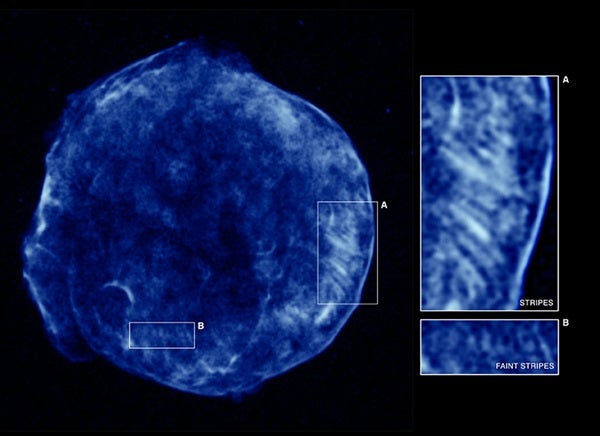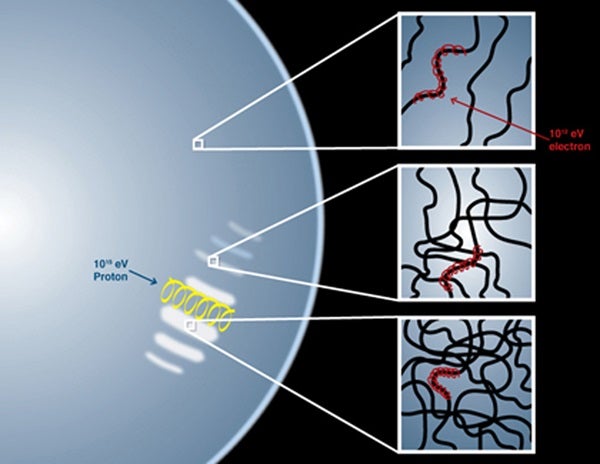This result comes from a long observation of the Tycho Supernova Remnant with NASA’s Chandra X-ray Observatory in Cambridge, Massachusetts. It could explain how some of the extremely energetic particles bombarding Earth, called cosmic rays, are produced.
“We’ve seen lots of intriguing structures in supernova remnants, but we’ve never seen stripes before,” said Kristoffer Eriksen, from Rutgers University in New Brunswick, New Jersey. “This made us think very hard about what’s happening in the blast wave of this powerful explosion.” This latest study from Chandra provides support for a theory about how magnetic fields can be dramatically amplified in such blast waves.
In this theory, the magnetic fields become highly tangled and the motions of the particles very turbulent near the expanding supernova shock wave at the front edge of the supernova remnant. High-energy charged particles can bounce back and forth across the shock wave repeatedly, gaining energy with each crossing. Theoretical models of the motion of the most energetic particles, which are mostly protons, are predicted to leave a messy network of holes and dense walls corresponding to weak and strong regions of magnetic fields, respectively.
The X-ray stripes discovered by the Chandra researchers are thought to be regions where the turbulence is greater and the magnetic fields more tangled than surrounding areas and may be the walls predicted by the theory. Electrons become trapped in these regions and emit X-rays as they spiral around the magnetic field lines.
However, the regular and almost periodic pattern of the X-ray stripes was not predicted by the theory.
“It was a big surprise to find such a neatly arranged set of stripes,” said Jack Hughes from Rutgers in New Brunswick, New Jersey. “We were not expecting so much order to appear in so much chaos. It could mean that the theory is incomplete, or that there’s something else we don’t understand.”
Assuming that the spacing between the X-ray stripes corresponds to the radius of the spiraling motion of the highest-energy protons in the supernova remnant, the spacing corresponds to energies about 100 times higher than reached in the Large Hadron Collider. It is thought that these energies equal the highest energies of cosmic rays produced in our galaxy.
Because cosmic rays are composed of charged particles, like protons and electrons, their direction of motion changes when they encounter magnetic fields throughout the galaxy. So, the origin of individual cosmic rays detected on Earth cannot be determined.
Supernova remnants have long been considered a good candidate for producing the most energetic cosmic rays in our galaxy. The protons can reach energies that are hundreds of times higher than the highest-energy electrons, but since they do not radiate efficiently like the electrons, direct evidence for the acceleration of cosmic-ray protons in supernova remnants has been lacking.
These results also support the prediction that magnetic fields in interstellar space are greatly amplified in supernova remnants, but the difference between the observed and predicted structures means that other interpretations cannot be ruled out.
“We were excited to discover these stripes because they might allow us to directly track, for the first time, the origin of the most energetic particles produced in our galaxy,” said Eriksen. “But we’re not claiming victory yet.”
The Tycho Supernova Remnant is named for the famous Danish astronomer Tycho Brahe, who reported observing the supernova in 1572. Scientists think the explosion occurred when a white dwarf star grew in mass and exceeded its weight limit, forming a so-called type Ia supernova. The Tycho remnant is located in the Milky Way about 13,000 light-years from Earth.
“Supernova remnants are our best cosmic laboratories for understanding how nature accelerates the highest-energy cosmic rays,” said Roger Blandford of Stanford University in Palo Alto, California. “These careful measurements provide a strong clue as to what actually happens at these giant shock fronts.”
This result comes from a long observation of the Tycho Supernova Remnant with NASA’s Chandra X-ray Observatory in Cambridge, Massachusetts. It could explain how some of the extremely energetic particles bombarding Earth, called cosmic rays, are produced.
“We’ve seen lots of intriguing structures in supernova remnants, but we’ve never seen stripes before,” said Kristoffer Eriksen, from Rutgers University in New Brunswick, New Jersey. “This made us think very hard about what’s happening in the blast wave of this powerful explosion.” This latest study from Chandra provides support for a theory about how magnetic fields can be dramatically amplified in such blast waves.
In this theory, the magnetic fields become highly tangled and the motions of the particles very turbulent near the expanding supernova shock wave at the front edge of the supernova remnant. High-energy charged particles can bounce back and forth across the shock wave repeatedly, gaining energy with each crossing. Theoretical models of the motion of the most energetic particles, which are mostly protons, are predicted to leave a messy network of holes and dense walls corresponding to weak and strong regions of magnetic fields, respectively.
The X-ray stripes discovered by the Chandra researchers are thought to be regions where the turbulence is greater and the magnetic fields more tangled than surrounding areas and may be the walls predicted by the theory. Electrons become trapped in these regions and emit X-rays as they spiral around the magnetic field lines.
However, the regular and almost periodic pattern of the X-ray stripes was not predicted by the theory.
“It was a big surprise to find such a neatly arranged set of stripes,” said Jack Hughes from Rutgers in New Brunswick, New Jersey. “We were not expecting so much order to appear in so much chaos. It could mean that the theory is incomplete, or that there’s something else we don’t understand.”
Assuming that the spacing between the X-ray stripes corresponds to the radius of the spiraling motion of the highest-energy protons in the supernova remnant, the spacing corresponds to energies about 100 times higher than reached in the Large Hadron Collider. It is thought that these energies equal the highest energies of cosmic rays produced in our galaxy.
Because cosmic rays are composed of charged particles, like protons and electrons, their direction of motion changes when they encounter magnetic fields throughout the galaxy. So, the origin of individual cosmic rays detected on Earth cannot be determined.
Supernova remnants have long been considered a good candidate for producing the most energetic cosmic rays in our galaxy. The protons can reach energies that are hundreds of times higher than the highest-energy electrons, but since they do not radiate efficiently like the electrons, direct evidence for the acceleration of cosmic-ray protons in supernova remnants has been lacking.
These results also support the prediction that magnetic fields in interstellar space are greatly amplified in supernova remnants, but the difference between the observed and predicted structures means that other interpretations cannot be ruled out.
“We were excited to discover these stripes because they might allow us to directly track, for the first time, the origin of the most energetic particles produced in our galaxy,” said Eriksen. “But we’re not claiming victory yet.”
The Tycho Supernova Remnant is named for the famous Danish astronomer Tycho Brahe, who reported observing the supernova in 1572. Scientists think the explosion occurred when a white dwarf star grew in mass and exceeded its weight limit, forming a so-called type Ia supernova. The Tycho remnant is located in the Milky Way about 13,000 light-years from Earth.
“Supernova remnants are our best cosmic laboratories for understanding how nature accelerates the highest-energy cosmic rays,” said Roger Blandford of Stanford University in Palo Alto, California. “These careful measurements provide a strong clue as to what actually happens at these giant shock fronts.”












